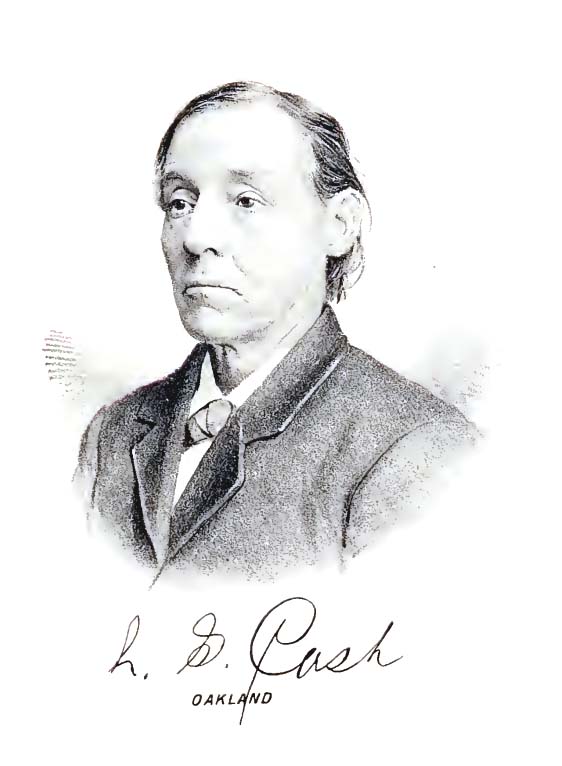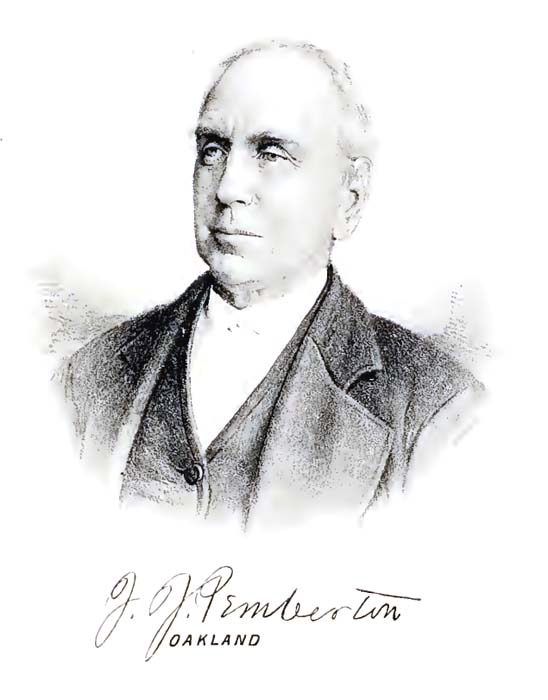"The proud bird,
The condor of the Andes, that can soar
Through heaven's unfathomable depths, or brave,
The fury of the northern hurricane
And bathe his plumage in the thunder's home,
Furls his broad wings at nightfall, and sinks down
To rest upon his mountain-crag; but Time
Knows not the weight of sleep or weariness,
And night's deep darkness has no chain to bind
His rushing pinions." -
Prentice. |
"Time, fierce spirit of the glass and scythe," sets his
signet upon the fading race of men, and they pass away "as a
tale that is told." The "enduring marble" points us to
the spot where sleep the pioneers whose magic touch changed
this country from a "howling waste" to the paradise we find
it to-day. More than fifty years have "flung their
sunshines and shadows o'er the world" since the first white
people came to Charleston Township and proceeded to settle
themselves to "grow up with the country." Fifty years!
How much has transpired in that half-century that has come
and gone since the "star of empire" crossed the "raging"
Embarrass and paused for a moment over this fair region.
We have neither time nor space to particularize the changes
that have taken place in all these rolling years. Go
ask the few old gray-heads still left how they have seen the
palace take the place of the "pole cabin," the railway-train
that of the patient, plodding ox, and the "wilderness
rejoice and blossom as the rose." They can tell you of
these changes far better than we, for they are things 'all
of which they saw and part of which they were.' Ours
is the duty to give the dry, historical details, and
faithfully we shall endeavor to perform the task.
THE EARLY SETTLEMENT.
The first permanent settlement was
made in Charleston Township in 1825. In that year,
Seth H. Bates settled here, having removed from Crawford
County. Jesse Veach, then a young man of
eighteen, "moved" him to this
Page 290 -
Page 291 -
Page 292 -
Page 293 -

L. S. CASH
Oakland
Page 294 - BLANK PAGE
Page 295 -
Page 296 -
Page 297 -
Page 298 -
Page 299 -
Page 300 -
Page 301 -
MILLS, STORES AND OTHER IMPROVEMENTS.
Page 302 -
Page 303 -
Page 304 -
EDUCATIONAL AND RELIGIOUS
Page 305 -
POLITICS AND PATRIOTISM.
Page 306 -
Page 307 -
BLOODED STOCK.
Page 308 -
Page 309 -
THE CITY OF CHARLESTON.
Page 310 -
Page 311 -

J. J. Pemberton,
Oakland
Page 312 - BLANK PAGE
Page 313 -
THE COURT HOUSE.
Page 314 -
Page 315 -
healthy establishments, officered by men who have a long
experience in banking and who possess the entire confidence
of the people and the community at large.
MANUFACTURING
Page 316 -
Page 317 -
VILLAGE ORGANIZATION.
THE CHURCH HISTORY.
Page 318 -
Page 319 -
Page 320 -
BENEVOLENT ORGANIZATIONS.
Page 321 -
Page 322 -
THE NEWSPAPERS.
Page 323 -
to John S. Theaker, who published it till October, 1866,
and sold it to Dunbar Brothers. Albert
Dunbar, one of the proprietors, died in 1875, when
Lucian Dunbar continued to publish it until in May,
1878, when he sold it to McConnell & Co., the present
proprietors. It is Republican in politics, and a live,
energetic newspaper.
George Harding, after his retirement from
the old Courier in 1857, established the Charleston
Ledger, which he published about two years, and sold it to
John M. Eastin. He sold it to McHenry
Brooks, who published it until 1867, and sold it to
Shoaff and Underwood. About this time the name
of the Courier had been changed to that of Plaindealer,
and Shoaff & Underwood changed the Ledger
into the Courier. Shoaff sold his interest
in about a year to Major Miller, who now publishes
a paper in Tuscola, and in about a year more. Miller
sold to E. B. Buck, who, with Underwood, published
the paper until about 1873-74, when Buck bought out
Underwood and has published it ever since. Mr.
Buck is an editor of considerable experience and an able
news- paper man, and has filled the office of President of the
State Press Association. His paper is true blue
Democratic, and a faithful exponent of the principles of that
party.
The grain trade of Charleston is not very extensive,
from the fact that a large proportion of it is fed to stock by
the farmers. Among the grain-buyers of the city is the
firm of Messrs. McDonald and Zink, who use
the elevator on the railroad owned by Traver & Nixon,
and who, in the grain season, do a very large business.
A feature of Charleston is the studio of Charles
Briggs. He was the first house and sign painter in
Charleston, and from that has taken up portrait painting.
We have seen several portraits of old citizens of Charleston,
which show considerable talent of the artist for this kind of
work. He has made a specialty of painting fine stock bred
in this county, in which he excels. Specimen paintings of
hogs from Shepard & Alexander's herds look so
natural that one naturally expects to hear them grunt and
squeal.
The Infirmary of Dr. Van Meter,
mentioned in another page, was, some years ago, one of the
largest institutions in Charleston. But years of labor,
and ill-health compelled the doctor recently to close it and
retire from active business life.
Mound Cemetery, Charleston's beautiful little city of
the dead, is located about one mile west of town, and is well
adapted for cemetery purposes. The name is well chosen,
being a large mound in the center, and the land sloping down in
all directions. The first cemetery is now in the city
limits and becoming pretty well filled. Mound cemetery was
laid off, as stated, one mile west of the city.
<
CLICK HERE to
RETURN to TABLE OF CONTENTS > |